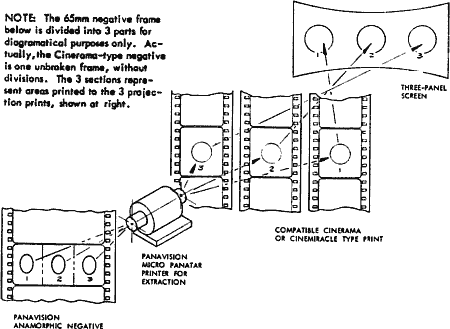|
|
|
|
|
|
|
|
|
|
|
|
|
|
|
|
|
|
|
|
|
|
|
|
|
|
|
|
|
|
These photographs clearly illustrate the field of view taken in by the Cinerama camera, and why it was so difficult to do intimate scenes with actors. Director Henry Hathaway (leaning on camera) rehearses the cast of How The West Was Won in The Rivers sequence. The sepia colored area shows the approximate field of vision of the camera. A frame set from that scene is shown below. The odd blocking of the actors was done to compensate for the parallax of the three separate panels. On the curved screen, the actors appeared to have the correct eye-lines.

Actresses Agnes Moorehead, Carroll Baker and Debbie Reynolds between takes. Miss Baker's closeness to the camera is indicative of what it takes to get a medium shot with Cinerama's 27mm lenses.
Again Henry Hathaway, this time directing The Outlaws sequence. In order to obtain a medium closeup (from the top of the actor's head to his waist), the camera had to be about 18 inches from the actors. With its plywood, lead, and fiberglass sound blimp, the camera weighed over 800 pounds. If the camera was running when this photo was taken, Henry Hathaway would be filling the left third of the picture, a problem that John Ford never understood when he filmed The Civil War sequence, causing many, many retakes. Years later, Hathaway, the driving force behind the production, admitted to having to reshoot much of director George Marshall's segment, and lamented that he didn't have the guts to redo John Ford's work, which proved to be the weakest segment, whose only exciting moments, ironically, are M-G-M Camera 65 elements lifted from Raintree County.
Seen below is the shot as it appears in the film. The image is taken from the 35mm anamorphic composite print, thus there is some loss to the sides of the Able and Charley panels. Frame reproduction courtesy of Greg Kimble. The images above are excerpted from his excellent American Cinematographer article on How The West Was Won.
Read New Greg Kimble Article on CINERAMAIn addition to converting some M-G-M Camera 65 (Ultra Panavision 70) scenes to three strip for the film, a number of Ultra Panavision shots were specially made. Also a few short snips were borrowed from John Wayne's Todd-AO production of The Alamo. The inherent lower resolution of the 70mm sources, coupled with the quality loss introduced in producing the optical extraction to three strip, make all the 70mm shots quite obvious when seen on a real Cinerama screen.
Seen above is a frame reproduction showing George Peppard working in front of a rear projection screen to show a medium shot of Zeb Rawlings struggling with a flatcar that is disintegrating under him. To achieve such a shot, a background plate was filmed in Ultra Panavision and used behind Peppard on a sound stage where the foreground and background action are re-photographed, again in Ultra Panavision. While not subject to the linear distortion that such a shot would have had it been filmed in Cinerama, the image appears unconvincingly flat and grainy in the resulting sequence. Despite the lesser quality of these segments, they did keep the talent from being injured. This was not the case when the sequence was being filmed in Cinerama on location, where an accident cost stuntman Bob Morgan an eye, arm and leg. We should be somewhat forgiving under these circumstances.
Panavision drawing of how their Micro Panatar printer lens was used to convert 65mm negatives to three strip for Cinerama projection. This lens was designed in about 1957 with the goal of making Cinerama films in Ultra Panavision but with three strip projection. While this drawing states that the negative is anamorphic, the same principal was used for spherical Todd-AO material in How The West Was Won. Panavision stated that this scheme was only practical if the three strip films were printed by the Technicolor dye transfer process, otherwise the prints would be too grainy. They were still very grainy, when compared to actual three strip photography.
Courtesy of David Strohmaier - Cinerama AdventureSeen above is an MGM alignment film (65mm) for extraction of Ultra Panavision to Cinerama three-panel prints. Well, that's not totally true. In fact it was first conceived by MGM's special effects head, A. Arnold Gillespie. His idea, for which a U.S. patent was received, was to create three flat 35mm films that could be rear projected onto a very large screen for use in films made in CinemaScope or Panavision. The projected images were carefully projected with precisely balanced light onto the large rear projection screen and actors & sundry other items were photographed from the front. The perilous raft sequence in How The West Was Won was produced in this manner so that Debbie Reynolds, Carroll Baker, Karl Malden, and Agnes Moorehead could survive after going down the rapids in the Ohio River. For some films only two rear projected panels were used depending on the needs of any particular scene. In addition to How The West Was Won, the system was also used on Mutiny on the Bounty, The Unsinkable Molly Brown, George Stevens' tedious The Greatest Story Ever Told, The Prize and a number of other films shot on the MGM lot.
Brown area represents the portion of the Ultra Panavision image extracted to the three Cinerama panels. The image has a 1.25x squeeze which is removed by the optical printer.
The proportions of the Ultra Panavision image after unsqueezing, approximately 2.6:1
You are on Page 3 of
E-mail the author
CLICK HERE©1996 - 2010 The American WideScreen Museum
http://www.widescreenmuseum.com
Martin Hart, Curator









